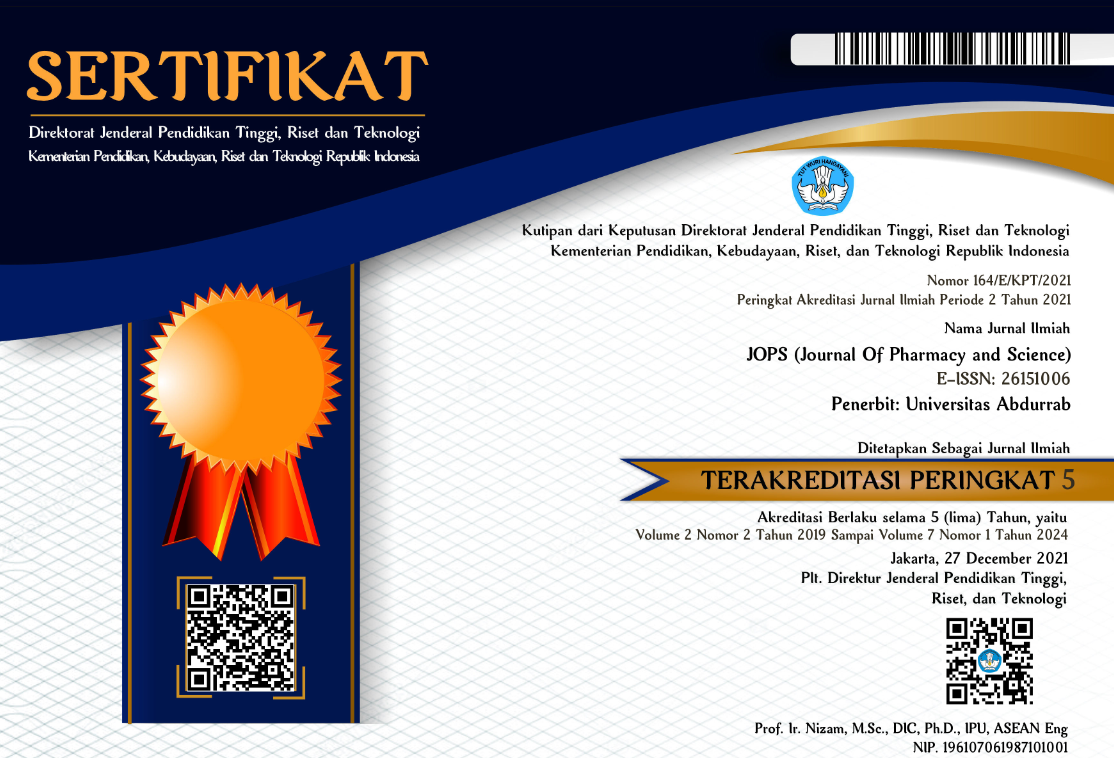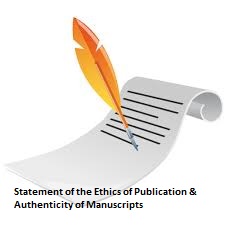Antihypertensive Effectiveness of Calcium Channel Blockers Compared to Angiotensin Receptor Blockers in Hypertensive Patients with Renal Impairment.
Abstract
Hypertension can cause damage to blood vessels in the kidneys so that the kidneys cannot filter blood properly. Appropriate and effective management of hypertension complicated by kidney disorders is needed in patients with kidney disorders to control blood pressure and slow down the occurrence of cardiovascular disease. The use of combination Calcium Channel Blocker antihypertensive drugs compared to combination Angiostensin Receptor Blockers has a therapeutic effect on lowering blood pressure in hypertensive patients with renal impairment. This study aims to determine the effectiveness of the use of antihypertensive Calcium Channel Blockers (CCB) combination compared to Angiotensin Receptor Blocker (ARB) combination in hypertensive patients with renal impairment outpatients at RSUD Kraton Pekalongan. This study is a non-experimental observational study with retrospective data on hypertensive patients with renal impairment from January to December 2022. The samples in this study were medical records of outpatients with hypertension and renal impairment who were given antihypertensive drugs of the CCB and ARB combination groups at the Public Hospital. Kraton that met the patient inclusion criteria. The results showed that the highest percentage of patients were over 60 years of age with 25 people (48%), male sex with 32 people (62%), use of antihypertensive drugs class ARB + diuretics with 16 people (30.7%) and use of antihypertensive group ARB + CCB + diuretic in 16 people (30.7%), the use of combined ARB and CCB drugs resulted in no increase in GFR in 29 people (55.7%) with the result p value = 0.570 p , the effect of drug use The combined ARB and combined CCB resulted in a decrease in blood pressure in 42 people (80.6%) with a p value = 0.178 p. Based on the results of the study, it can be concluded that the most patients are patients aged over 60 years with the sex of male patients, and there is no difference in the effectiveness of using antihypertensive groups CCB and ARB in hypertensive patients with kidney disorders in outpatient care at Kraton Pekalongan Hospital
References
[2] World Health Organization, World health statistics 2015. Geneva: World Health Organization, 2015. Accessed: May 29, 2023. [Online]. Available: https://apps.who.int/iris/handle/10665/170250
[3] Collins, “Dalam R.Atlas of chronic kidney disease & end stage renal disease in theunited states American journal of Juornal of disease.” American : the official Journal of the national Kidney Foundation, 2009.
[4] Dziedic, “Plasma and erutrocyte relations of catecholamins in hemodialisys patient.” Annals of Agricultural and Eviromental Medicine, 2014.
[5] D. Hadrianti, “HIDUP DENGAN HEMODIALISA (PENGALAMAN HEMODIALISA PADA PASIEN GAGAL GINJAL KRONIK),” 2020.
[6] W. Kinanti, T. M. Andayani, and F. Irijanto, “Perbandingan Efektivitas Angiotensin Receptor Blocker (ARB) dengan Calcium Channel Blocker (CCB) Pada Pasien Penyakit Ginjal Kronis dengan Hemodialisis,” JPSCR J. Pharm. Sci. Clin. Res., vol. 7, no. 1, p. 28, Mar. 2022, doi: 10.20961/jpscr.v7i1.53514.
[7] JNC VIII, “JNC VIII The Eight Report of Joint National Commite Hypertension Guidlines.” Am J Manag care, 2014.
[8] R. T. Pinzon, M. B. H. Padmanaba, E. A. Pramudita, and S. Sugianto, “Pola Terapi pada Faktor Risiko Kardioserebrovaskuler Pasien Penyakit Ginjal Kronis yang Menjalani Hemodialisis,” J. Farm. DAN ILMU KEFARMASIAN Indones., vol. 6, no. 1, p. 32, Jul. 2019, doi: 10.20473/jfiki.v6i12019.32-36.
[9] N. Widjaya, F. Anwar, R. Laura Sabrina, R. Rizki Puspadewi, and E. Wijayanti, “Hubungan Usia Dengan Kejadian Hipertensi di Kecamatan Kresek dan Tegal Angus, Kabupaten Tangerang,” YARSI Med. J., vol. 26, no. 3, p. 131, Feb. 2019, doi: 10.33476/jky.v26i3.756.
[10] C. Septiwi, “HUBUNGAN ANTARA ADEKUASI HEMODIALISIS DENGAN KUALITAS HIDUP PASIEN HEMODIALISIS DI UNIT HEMODIALISIS RS PROF. Dr. MARGONO SOEKARJO PURWOKERTO,” 2011.
[11] KDGO, “KDIGO Clinical Practice Guidline for the Evaluation Management Chronic Kidney Disease.” Kidney International Suplement, 2012.
[12] J. T. Atmojo, M. M. Putra, N. M. D. Y. Astriani, P. I. S. Dewi, and T. Bintoro, “Efektifitas Terapi Relaksasi Benson Terhadap Tekanan Darah Pada Penderita Hipertensi,” Interest J. Ilmu Kesehat., vol. 8, no. 1, May 2019, doi: 10.37341/interest.v8i1.117.
[13] A. Kadir, “Hubungan Patofisiologi Hipertensi dan Hipertensi Renal,” J. Ilm. Kedokt. Wijaya Kusuma, vol. 5, no. 1, p. 15, Feb. 2018, doi: 10.30742/jikw.v5i1.2.
Copyright (c) 2023 JOPS (Journal Of Pharmacy and Science)

This work is licensed under a Creative Commons Attribution-NonCommercial-ShareAlike 4.0 International License.
1. Copyright of all journal manuscripts is held by the JOPS (Journal Of Pharmacy and Science)
2. Formal legal provisions to access digital articles of electronic journal are subject to the provision of the Creative Commons Attribution-ShareAlike license (CC BY-NC-SA), which means that JOPS (Journal Of Pharmacy and Science) is rightful to keep, transfer media/format, manage in the form of databases, maintain, and publish articles.
3. Published manuscripts both printed and electronic are open access for educational, research, and library purposes. Additiponally, the editorial board is not responsible for any violations of copyright law.
licensed under a Creative Commons Attribution-ShareAlike 4.0 International License.
 PDF (Bahasa Indonesia)
PDF (Bahasa Indonesia)
 Abstract views: 85
Abstract views: 85
 downloads: 59
downloads: 59

 :
:
1.png)








